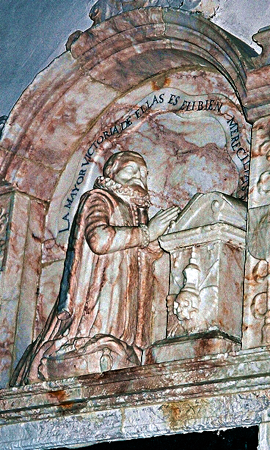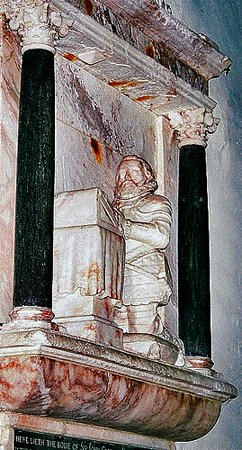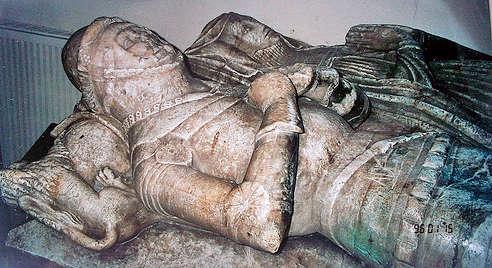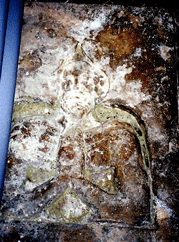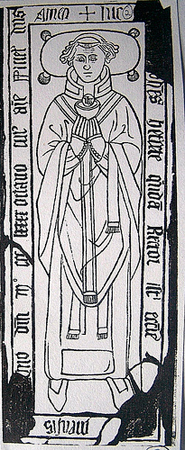|
|
Leasingham
Little Seeping
Louth
Newton-by-Toft
Nocton
Norton Disney Pinchbeck
(Rand) (Redbourne)
Riby (Rippingdale) Scawby
Scotton Scredington
(Scrivelsby)
Snarsford
South Cockerham South
Kelsey
South
Stoke or Stoke Rochford
South Willingham Spilsby
Stallingborough
Stenigot Stow
Strubby Swineshead
Swinhope
Tatwell Thornton
Abbey Uffington
Utterby
Washingboorough
Wellingore West Rasen
Willoughby
(Wilsthorpe)
Wisperton |
| |
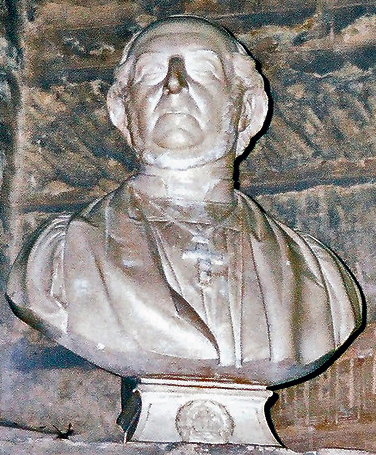 |
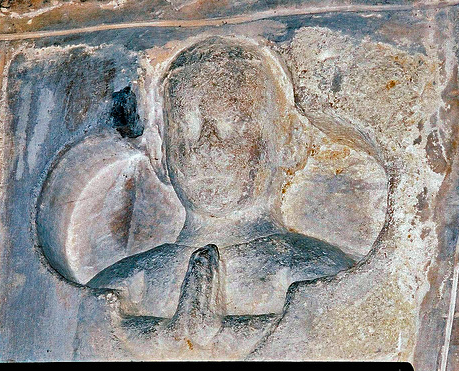 |
Edward Trollope
Bishop of
Nottingham, Rector (1843-1893) |
Bust of Lady |
|
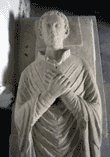 |
Thomas of Reading,
Rector (1318-1353) The inscription is
in Norman French |
|
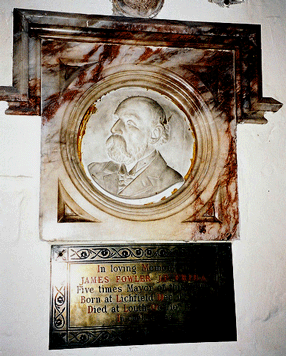 |
James Fowler
JP (1828-1892)
Five times mayor. Known as 'Fowler of Louth' he was an
ecclesiastical architect, associated with restorations; he was
diocesan surveyor 1871-1888 |
|

|
There are several monuments are of the 19th
century with work by John Bacon Jnr, Richard
Westmacott & G P White. They include that above to
the First Earl of Ripon (1859)
designed by Scott with a recumbent white marble
effigy by Mathew Nobel 1862
AlsoA tall standing
monuments in white & gray marble to Sir William Ellys
(1680) attributed to William Santon;
no figures.
|
|
|
 |
 |
| Helaine |
William |
| A pair of minature stone effigies, he 29", she 24";
their names are carved on the slabs. |
|
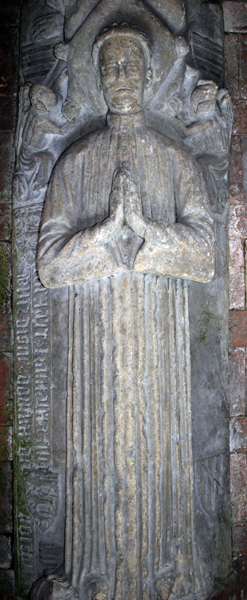 |
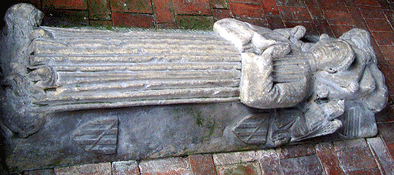
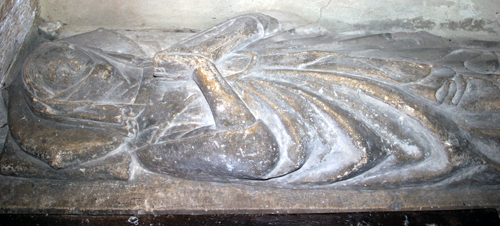
Above top and left: Lady 14th century. Note her
feet resting on lions and the shields with the D-Iseni arms on the plinth. The
inscription reads: Here lies
Hautacia,
daughter of William Disney, Lord of Norton.
Above bottom and right: A Disney Lady c. 1300
Slender figure under an arch in the north wall with d'Isigny
shields in wall behind.
|
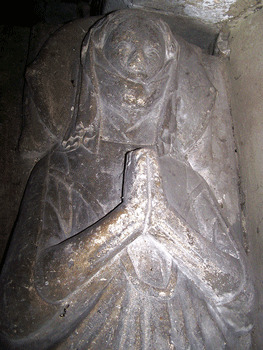
Right:
Joan Disney mid 14th
century.
An elaborate semi-effigial slab. It features a cusped
straight-armed cross flanked by shields, above which is a canopy
with the sunk-relief bust of a lady with flowing hair, resting
her head on a pillow and wearing a tight sleeved gown, buttoned
from the wrist to the elbow, hands in prayer. Within the cusped
architectural mount of the cross are her feet, lying on a hound,
again in sunk relief. The incised Norman-French Lombardic
inscription around the slab records her being Joan, wife of Sir
William Disni and daughter of Nicholas de Lancforte. A similar
effigy to a member of the same family is at Kingerby. |
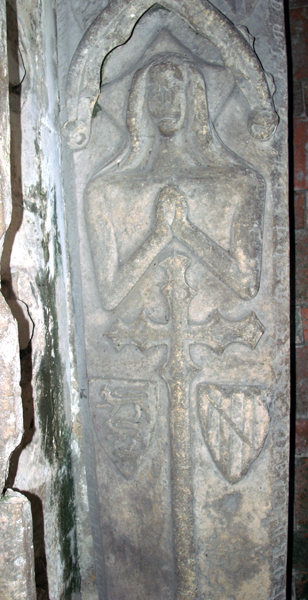 |
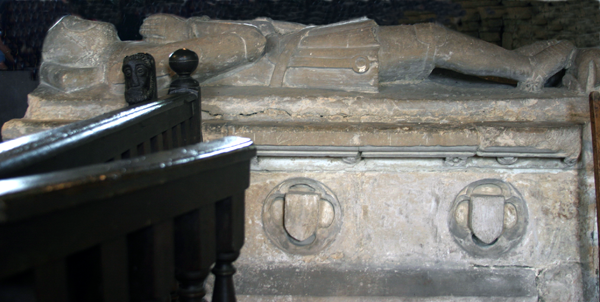 |
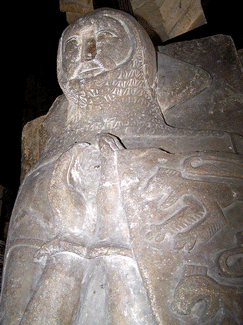 |
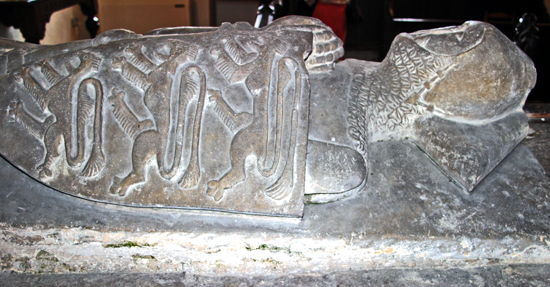 |
| A Disney (d'Isigny) c 1350.
Knight on tomb-chest. Straight legs,
shield carved with d'Isigny arms in relief |
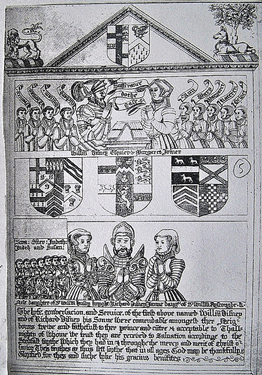 |
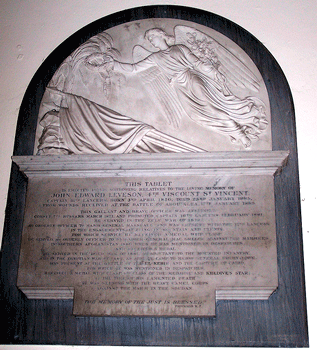
|
Above left:William Disney (1540)
and family. An unusual geneological brass of c 1580. A
quadrangular plate with two panels of demi-effigies. The
upper shows William facing his wife, Margaret Joiner,
across a prayer desk, with behind their 5 sons and 4
daughters, their names in scrolls. Below, forward facing
are Richard Disney (1578), William's heir, and his
two wives, Nele Hussey and Jane Ayscough. Behind Nele
are arranged 7 sons and 5 daughters, but the area behind
Jane is blank, indicating that she was childless. The
boys' names have been cut out but the girls' survive.
This is a palimpsest brass, the reverse having been part
of a Flemish incription (another portion of which is on
the back of a brass at West Lavington, Wiltshire)
recording the endowment of a mass in 1518 by Adrian
Adrianson and Paechine van den Steyne in the church of
Westmonstre in the city of Middleburgh. The brass is
mounted on a hinge so that both sides can be viewed. The
Netherlands were under the unpopular rule of the
Catholic Spanish King, Phillip II and opposition under
the protestant William the Silent led to destruction in
the Low Country churches, initially motivated by
iconoclasm but later the raise money; much brass scrap
was sold to London and Norwich based brass engravers.
This Disney brass is illustrated
in Gough Sepulchral Monuments Volume I Part 1 facing
page cxxii.
The d'Isneys are ancestors of Walt
Disney.
Above right: Fourth Viscount St Vincent
by
J. S. Westmacott, 1887. Angel with
a wreath hovering over a flag. Still in the Georgian
tradition of the Westmacott family
Also but not shown: Sir William Disney,
husband of Joan above. Brass indent which shows a
cross-legged knight under a canopy, with a fillet
inscription round the perimeter of the slab. c
1330 |
|
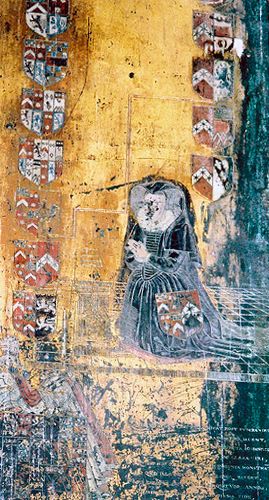 |
Margaret
Carr
(1603) wife of
John Lambert. Painted &
gilded brass. Her arms are on the left; her husband's on the
right, supposedly going back to the time of William the
Conqueror. The marriage arms are on her dress. |
|
Two fine medieval monuments:
A coped coffin lid in Tournai marble, c. 1200
A lady of the late 13th century, shield on her middle,inspired by the Angel Choir of Lincoln Cathedral.
The five other monuments are Elizabethan to Jacobean.
|
|
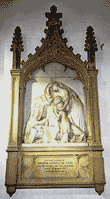
Left: 9th Duke of St Albans
(1851); a big relief of a mourning mother and
two children by J G Lough.
Low tomb recess
with cusped ogee arch.
Incised slab to Sir Gerald
Sothill (1410) of foreign manufacture according
to Greenhill.
William Carter (1752)
& Roger Carter (1774); both of
c 1775 by Richard Hayward. Very fine.
Charlotte Carter Thelwall
(1780), also by Roger Hayward.
Lady William Beauclerk
(1781); Grecian.
Duchess of St Albans
(1837), a draped Greek altar by Chantrey.
She was the window of Thomas Coutts.
|
|

Left: William and Elizabeth
Tomline (1773) free standing wreathed urn in
niche; above a small tablet with woman by urn with
drapery from above. Signed: L. Tomline Delineat
Marmaduke Tomline (1803)
Signed E Tomline delineat and P M VanGelder
fecit 1806
John Parkinson (1840)
white marble |
|
Deacon, mid 13th century, holding open book
with inscription; very rare type.
knight (late 13th
century. Cross legged
Another similar but defaced.
Early to mid 14th century
lady on tomb chest; ogee canopy above her head
& similar above whole tomb.
Richard de Quincey &
Wives( Late 15th century) male with two ladies;
effigies on tomb chest with angels holding shields in
panel
The Brownlow children
of 1669 and earlier: An aedicule. |
|
|
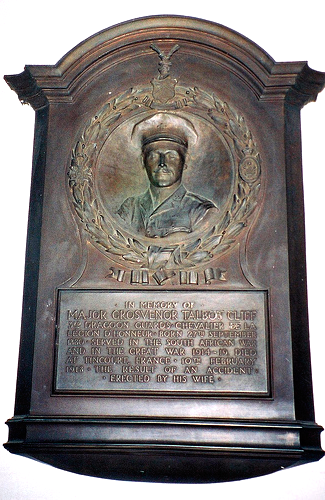 |
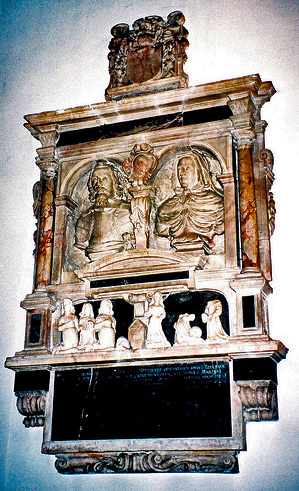 |
Mjr Grosvenor Talbot Cliff (1913)
Chavelier de la Legion D'Honneur.
Died st Tincort,
France as a result of an accident |
Richard Nelthorpe (1640) & Ursula
Attributed to
Marshall workshop |
|
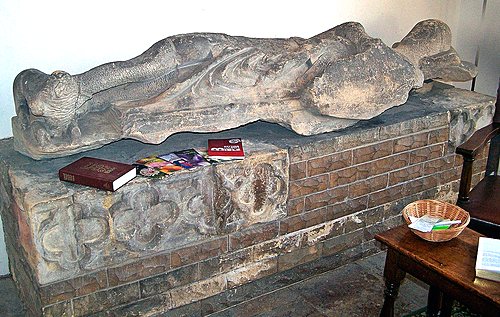 |
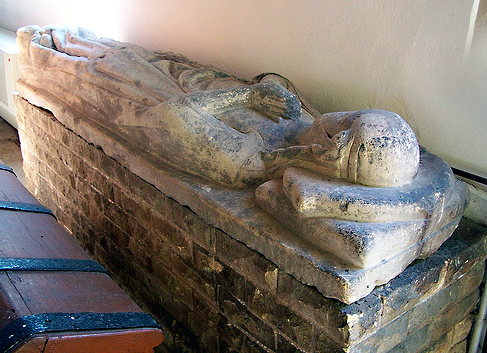 |
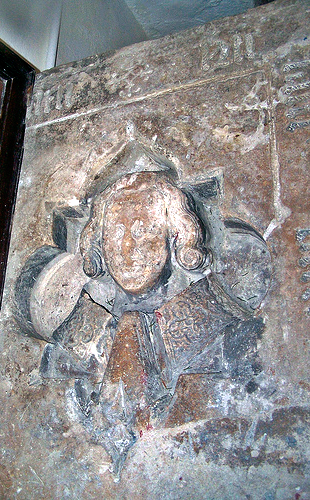 |
| Above
left: Robert de Neville (?) c 1300.
Above right: Lady said to be wife of the above.
Right: Hugh Hannesworth 15th century
priest |
|
|
Scredington - St Andrew |
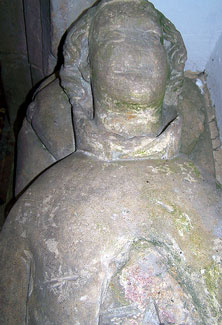 |
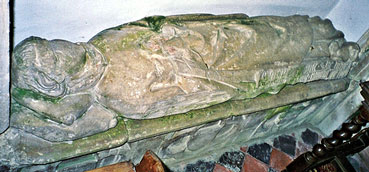 |
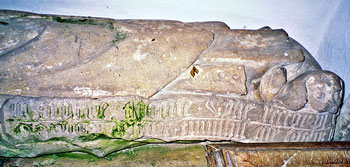 |
|
Thomas Wyke (c 1394) priest. Note the dog at his feet,
besides which is an inscription: 'Memore Thomas Wyke rector
PX guadia de p me tumulus'. |
|
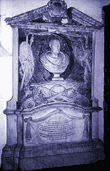 Left:Lewis Dymoke (1760),
standing wall monument of white and beige marble. At
base snake biting tail and two extinguished torches. By W Atkinson. Left:Lewis Dymoke (1760),
standing wall monument of white and beige marble. At
base snake biting tail and two extinguished torches. By W Atkinson.
A Marmion & wife,
cross legged knight & lady, c. 1300.
Sir Robert Dymoke (1545),
brass effigy on tomb chest.
John Dymoke (1784),
by Richard Haywood.
Lewis Dymoke (1820)
by Mullane.
John Tyrwhitt (1844)
by King.
Emma Dymoke (1884)
In the churchyard Romanesque table
tomb with eight legs. |
|
 Left:
Sir George St Paule
(1613) & wife, a big standing wall monument
. The effigies lie on their sides propped up on
their elbows, he behind and a little above his wife. Left:
Sir George St Paule
(1613) & wife, a big standing wall monument
. The effigies lie on their sides propped up on
their elbows, he behind and a little above his wife.
Sir
Thomas St Paule (1582) & wife, alabaster. A
six-poster with poorly executed recumbent effigies. Flat
top on which kneeling children.
Robert Lord Riche, Earl of
Warwick (1619) & his last wife (widow of Sir
George, above); alabaster tablet with effectively
arranged busts. Possibly by Epiphanius Evesham.
The Earl was buried at Felsted, Essex. |
|
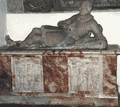 Sir
Adrian Scrope (1623), alabaster semi-reclining
effigy. Against tomb chest kneeling daughters and sons.
By Epiphanius Evesham.(shown) Sir
Adrian Scrope (1623), alabaster semi-reclining
effigy. Against tomb chest kneeling daughters and sons.
By Epiphanius Evesham.(shown) |
|
|
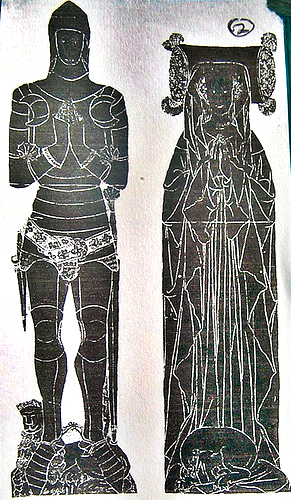 |
South Kelsey -
St Mary |
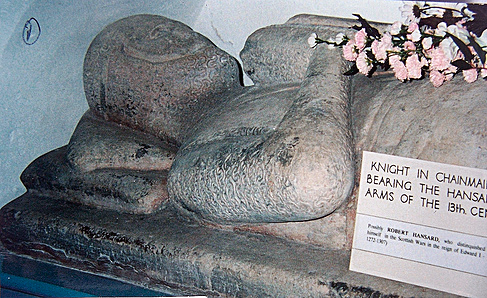 |
|
 |
Right:Richard Hansard (1410) &
Joan (1397)
Above: Said to be
Richard (1313)
or Robert Hansard
who fought in the Scottish Wars under
Edward I |
|
 Sir John de Neville (1316) Effigies of couple under a blanket from which protrude
busts and feet; early 14th Sir John de Neville (1316) Effigies of couple under a blanket from which protrude
busts and feet; early 14th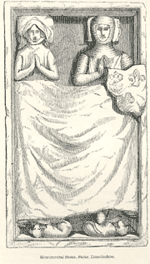 century
(right) century
(right)
Fine tomb recess; tomb chest with shields.
Tomb chest with shields in quatrefoils.
Tomb chest with shields in ogee headed
fields; big ogee canopy.
Brass of Henry Rochford (1470)
Brass of Oliver St John (1503) & Wife.
Henry Cholmeley (ob 1640); big standing
monument in the centre of which the kneeling couple are flanked
by columnist the left and right and also flanked by columns, two
kneeling children. (left)
Alice Cholmeley (1668), tablet with
drapes.
Sir Edmund Turnor (1707) but erected c
1679 on the death of his wife. Large reredos composition of
black & white marble with flanking columns and pediment with
urn. By William Stanton.
Montague Cholmeley (1831) by
G Wilcox &
R Blore.
Christopher Turnor (1886) & wife;
marble with portraits in profile in roundels; designed by
Christopher Turno |
|
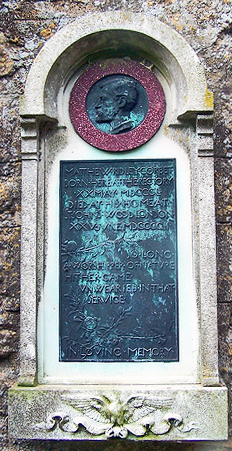
Matthew Ridley Corbet (1911)
the painter who
was born in the rectory here and died in St John's Wood,
London
|
|
|
|
Spilsby - St James |

|
Series of Willoughby & Bertie
monuments in chapel:
Knight (cross legs)
& lady, 1st half of 14th century;
on a tomb chest with buttresses (which carry pinnacles, not,
however, original). Attributed to Robert, 1st Lord
Willoughby (1348).
John, 2nd Lord (1372);
alabaster effigy flanked by shafting with tiny figures of monks.
Tomb chest with figures holding shields. He fought in the 100
Years' War with Edward III and the Black Prince, distinguishing
himself at Poiters in 1365. (left top)
John, 3rd Lord (1396) & wife.
Alabaster effigies on tomb chest, much renewed.
Margaret (1391), 3rd wife
of above; brass.
William, 5th Lord (1410) & wife;
brasses under canopy.
Richard Bertie (1582) &
wife, Baroness Katherine Willoughby de Eresby
and former Duchess of Suffolk (1580). A large
monument which fills west wall of chapel. The back of the
monument, like a reredos, has three Ionic columns separating
fields with passages from the Bible, five in Latin & one in
English; below is a tomb chest projection. To the east, the
front of the monument, there is again a tomb chest projection
with colonettes and shields. Above are three large and coarsely
carved figures of a hermit, a Saracen king and a "woodwose" or
wildman of the woods (All Willoughby badge) between which niches
with columns, in which are well carved but out of proportion
alabaster busts. Katherine & Richard were Protestants and
friends of Bishop Latimer and left the country in Mary's reign,
their son, Peregrine (The Wandering Falcon, see below) was born
during their wanderings. (left middle)
Peregrine Bertie, 10th Lord (1601) &
daughter, who died in childbirth (1610), dated 1612. The
latter is represented semi-reclining with a baby in bed at her
feet. Above in an arches niche is the 10th Lord, represented in
what is probably the first standing monumental effigy in
England.
Sir John Franklin,
the explorer (1847) tablet with portrait in relief. He died in
the Arctic Seas attempting to find the North West Passage. He is
also commemorated in a
famous ballad. (left bottom). Other
sites about Franklin are
here and
here. |
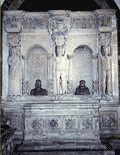
|
 |
|
|
Stallingborough SS Peter & Paul |
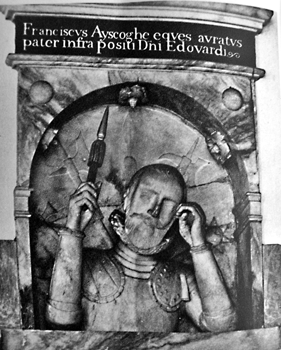 |

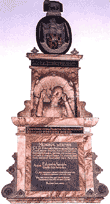 |
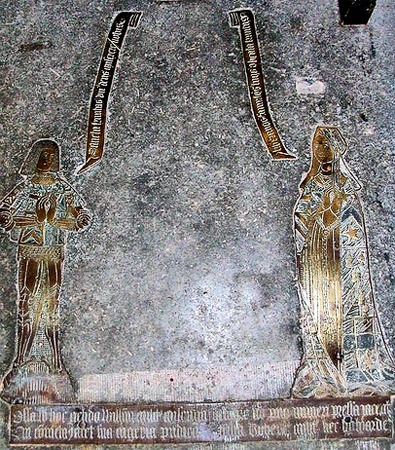 |
| Sir Francis Ayscough ,
bust in arched recess. This was the brother of Anne Ayscough who
tradition has it was the person who betrayed her. He expression
is said to be "cold and chilling". |
Sir Edward Ayscough (1612) & wife,
alabaster. Children kneel on tomb chest |
Sir William Ayscough
(1509) & Margery,
brasses |
|
|
Right: Richard Cecil (1587) & wife;
alabaster with two figures kneeling, facing across a prayer desk
with three daughters kneeling below. By Cornelius Cure.
William Cecil, Lord Burghley
(1598), Queen Elizabeth's adviser. A six poster
alabaster (shown) with recumbent effigy on a rolled up mat. Top
with arms. Perhaps by Cornelius Cure.
William Wissing, the
painter (1687), small tablet.
Edward Dethe (1687),
tablet
John, 5th Earl of Exeter (1700);
large sarcophagus with semi-reclining figures at the base of
which figures representing Victory and Art. By P. É. Monnot,
Rome; erected by William Palmer in 1710.
Noal Neal (1769) by
Sparrow
William Mackenzie (1770)
James Davie (1785) by
Bingham
|
|
Cyril Jackson (1797) by
Westmacott.
John Truman (1788) by
Bingham.
William Harper (1803) by
Bingham
Elizabeth Plumptre (1806)
by William Harrison.
Thomas Truman (1810) by
Harrison.
Mary (1814) & Henrietta (1817)
Mottram
John Lawson (1828) by
Gilbert
Martha Etough (1835) by
Smith of Stamford
Edward Henry (1862) & Henry Poyntz
Cecil ( 1858) White marble with large frontal angle and
portrait medallions below. By G M Benzoni of Rome (1864)
Brownlow Cecil (1867), a
Gothic tablet.
Lord Thomas Cecil (1873)
by Millward & Co, London.
There is also a large group of mainly
plain 19th century tablets. |
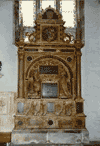 |
|
|
|
Richard Earle (1697).
A hanging wall monument of various marbles consisting of
a wall plaque with plinths, on which are two busts and
cherubs with skulls. The inscription, shown below, also
appears on a totally different monument in Twyford,
Berkshire. By Thomas Green of Camberwell.
|
Stragglethorpe
St Michael |
Stay, Reader and observe
Deaths partial doom
A spreading Virtue in a
narrow Tomb,
A generous Mind mingled
with common Dust;
Like Burnishd Steel
cover'd and left in Rust.
Dark in the Earth he
lies, in whom did Shine
All the Divided Merits of
his Line,
The Lustre of his Name
seems faded here,
No fairer Star in all
that fruitfull Sphere.
In Piety and Parts
extremely Bright;
Clear was his Youth, and
filled with Crowning light
A morn that promised much
Yet saw no Noon
None ever Rose so fair,
an Set so soon
All lines of Worth were
Centred here in One,
Yet see, he lies in
Shades, whose Life had none,
But while the Mother this
sad Structure Rears,
A double Dissolution
there Appears;
He into Dust dissolves,
She into Tears
Richardus Earle Bar.nt
Obyt
Decimo Tertio Die Augufti
Anno Dom 1697 Aetatis
Suae 24 |
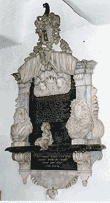 |
|
|
|
|
Stowe - St Mary |
 |
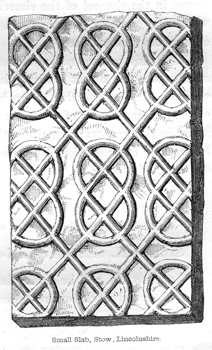 |
Above: Small
slab
Right: Lady
(13th century) coffin lin with head and praying
hands sunk in roundel
There is a second similar slab; one has an English inscription
rounf the edge: Alle men yat ben in lyf prai
for Emme was Fulk wife |
|
|
 |
 |
| Cartouche to an unknown lady |
William Ballett (1648) & his two wives:
Joan & Susanna He died age 99 and the figures
are represented in Elizabethean clothing, showing him as a
younger man. Note the children are shown above and behind
rather than below. |
|
|
|
Swineshead - St Mary |

 |
Kneeling children and babies from the monument to Sir John
Lockton (1610). The only remains of this monument |
|
|
Swinhope - St Helen |
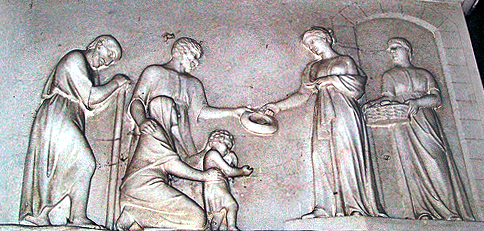
|
| Charlotte Mary
Pye (Yerburgh) (1847) Also to her two children, both
sons, one of who died shortly after birth in 1827, and the other
at 12 days in 1827. A daugher, also Charlotte, lived until 1869.
Although the husband's name was Pye, he was the son of
Reverend Marmaduke Alington but took the name Pye under the
terms of the will from which he inherited the fortune of his
aunt, Sarah Rowe. By T Gaffin |
|
|
|
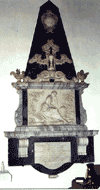
|
Tathwell - St Vedast |
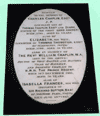
|
|
Edward Hanby (1626) and Wife standing albaster
wall monument in four tiers: at foot kneling children in relief,
then the couple kneeling and facing each other across a pryer
desk, then a kneeling son (1626) and then the
acheivements. Inscription.
Thomas Chaplin (1747)
obelisk with double winged hour glass; seated mourning woman by
urn. By Hoare of Bath (shown left)
Charles Chaplin ( 1795), wife
Elizabeth (1785), Revd William Chaplin MA (1835) and wife
Isabella Frances (1824). Tablet signed by W T Hale,
Baker Street, London.(shown right)
|
|
|
Thornton Abbey |
| An
Augustinian Abbey with a fine gatehouse and ruins of part of the
church |
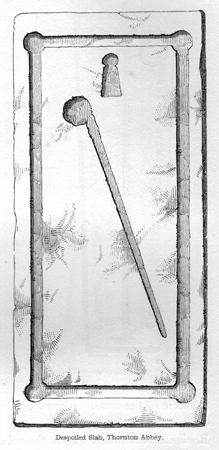 |
 |
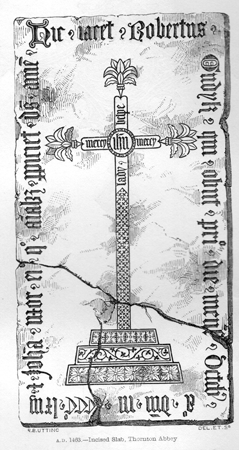 |
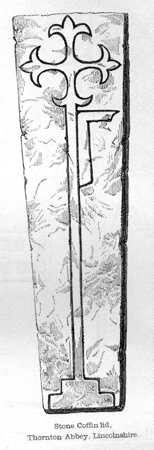 |
| |
|
|
|
|
Uffington
St Michael |
|
Knight
(1400) on tomb chest with ogee canopy.
Roger (1587) and
Olyver Manneres; two kneeling knights facing
each other; alabaster, c. 1607.
Dean Staunton (1612);
again two alabaster figures facing each other. This and
the above are signed by Green of Denton but he was the
19th century restorer.
Tablet with inscriptions on
drapery - 1679 .
Another similar of 1710.
|
|
|
Utterby - St Andrew |
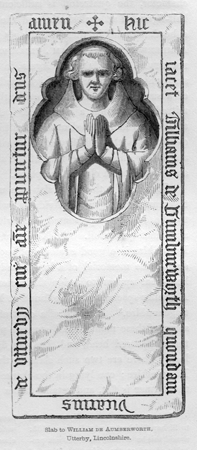 |
Priest (1373)
demi-effigy
in sunk relief in
quatrefoil surround;
inscription |
|
|
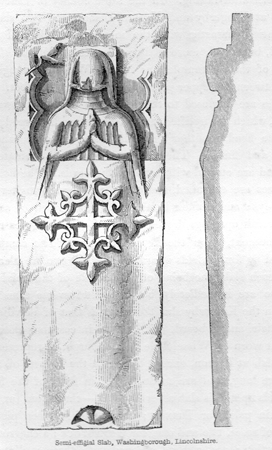
|
Washingborough -St John the Evangelist |
|
Left: Lady sunk
in relief. Note the feet peeping out at the bottom
Lady similar to
above but head is sunk in simple trefoil recess.
South outside the chancel
A Eure (1664)
tablet with inscriptioin in convex oval
Ann Rudgard (1844)
profile portrait
|
|
|
|
|
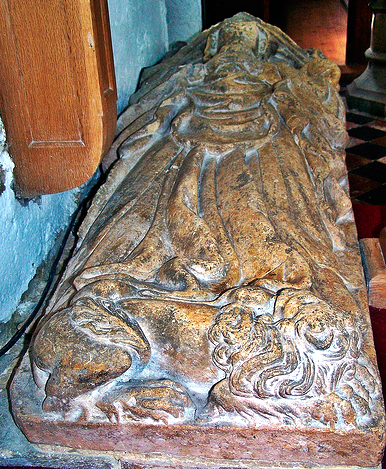 |
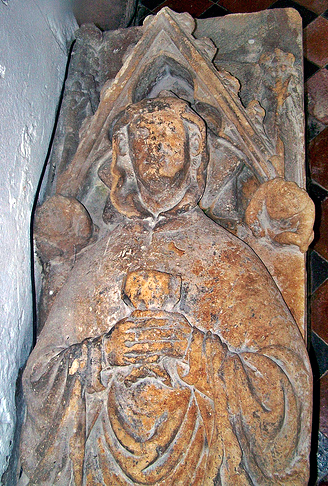 |
| Priest 14th century |
|
|
Wilsthorpe - St Faith |
|
Knight ( 1340) cross
legged. This is not - as often claimed - a 17th century
fake (e.g. Pevsner Lincolnshire) but an exceptionally interesting medieval figure,
with the unique feature of having an inscription around
the hem of the surcoat which is not only in Middle
English but neither an epitaph nor a religious theme. It
suggests he was either an early peace protester ot
member of a local jousting society! In Modern English is
reads: Peace is better than wars.
(information
from Dr Claude Blaire)
|
|
|
| |
|
|
|
|
| <Lincolnshire - 1>
<Lincolnshire - 2> <City of Lincoln>
<Top of Page> <Home
- Index - Page> |
| |

















































 century
(right)
century
(right)

